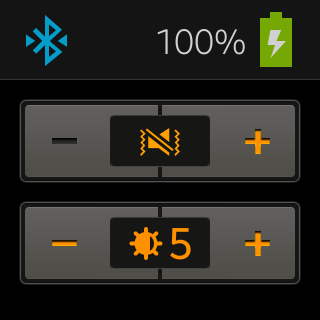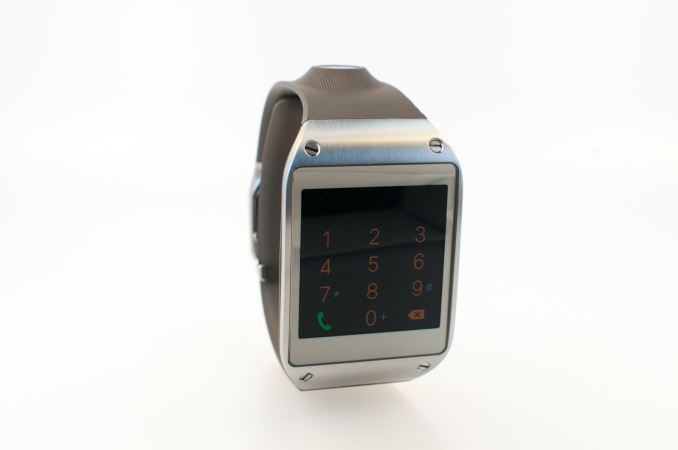Samsung Galaxy Gear Review
by Brian Klug on October 1, 2013 9:00 AM EST- Posted in
- Wearables
- Smartphones
- Mobile
- Galaxy Gear
- galaxy note 3
- watches
Battery Life
Gear’s designers went in a direction that completely defies most of the norm we’ve seen in this latest crop of smartwatches. Rather than the low power Cortex M3 route that seems to be popular, Samsung went with a dual core SoC (Exynos 4212), disabled a core, and set the CPU frequency to a maximum of 800 MHz. On top of the whole thing runs Android 4.2.2 and the Gear software, making the watch more like a small smartphone. The combination of aggressive display timeout (with a maximum of 5 minutes) and the activation gesture for waking the watch up signals to me that battery life probably was a challenge on the Gear.
I don’t really know what the best way is to battery life test a watch yet, and I struggled with that while trying to review Pebble. I settled on just timing how long I got through a battery charge there, which ended up being almost exactly a week (7.02 days was my average), which is basically my only context for what smartwatch battery life should be. The Gear obviously has a considerably more powerful platform, display, and capabilities, so it isn’t a shocker that battery life overall is less.
It’s easy to get around the display timeout limitations and just keep the display on Gear turned on forever, displaying the watchface. I ran a rundown test with the watchface set to brightness level 4 (there are levels 1–5 and outdoor brightness) while connected over Bluetooth to the Note 3. Gear managed 5.117 hours of total screen-on time showing the watch face (clock plus weather) connected to Note 3.

Of course the way that Gear is setup which prevents display from being on all the time, battery life during actual use will be longer. I’d say somewhere just over a day would be on the short side, maybe two or three days is possible if you try to stretch it a lot. I placed a few calls and played with Gear a lot one day and almost didn’t make it through, another day I felt like Gear would’ve lasted two had I let the use pattern continue.
The positive side is that thanks to its smaller battery, Gear can charge from completely drained to 100 percent in just under an hour, the simultaneous downside is that you need the charging cradle to do it. If you’re comfortable charging the Gear daily, it’s survivable, the question is whether consumers are willing to adopt the daily charge requirements of another device. I’ve gotten in the habit of plugging Pebble in every night, so this isn’t a big deal for me, but I also enjoy having a week of battery life when I go travel. I suspect that’s a use pattern that others can empathize with when considering Gear, which guarantees a little over a day of use realistically, and a bit more if you’re careful.











70 Comments
View All Comments
et20 - Tuesday, October 1, 2013 - link
Don't worry.I'm sure they'll figure it out in mere minutes after Apple introduces their iWatch.
colonelclaw - Tuesday, October 1, 2013 - link
Indeed. The design of this watch screams 'pre-Apple'. It also screams 'We got to the market 1st!', even though it looks, frankly, ridiculous.In my opinion, something as visible as a watch (this goes for all watches) needs to be an object of beauty, something that when you see on someone else's wrist, you want to get one yourself. Nothing would persuade me to wear this huge plastic lump.
prophet001 - Tuesday, October 1, 2013 - link
I hate it when they give out free Kool-Aid. The swarming is always imminent.bji - Tuesday, October 1, 2013 - link
Those posts were interesting and insightful. Yours ... not so much.Fergy - Wednesday, October 2, 2013 - link
In what way were they interesting and insightful? The Samsung bashing? The Apple worshiping? Or the opinion that the watch isn't for him so nobody should like it?DaHarder - Wednesday, October 2, 2013 - link
Exactly... and those of us who truly love tech can easily see Samsung's effort here as solid and far ahead of the wearable technology game, whereas most other major brands are just sitting by waiting to leach off of the foundation Samsung is laying.steven75 - Wednesday, October 2, 2013 - link
Far ahead? Please. The *watch* display is mostly off. It's a watch that fails to do what every watch since the beginning of time (see what I did there?) has been able to do. Tell time easily!The "waiting to leach off the foundation Samesung is laying" is also comedy gold.
whyso - Tuesday, October 1, 2013 - link
Its so Apple can't sue them over something retarded.RadarTheKat - Thursday, October 3, 2013 - link
I see a lot of comments on these articles that show a lack of comprehension regarding patent law and how it applies. I thought I'd provide a bit of insight here for those who might not be conversant in the topic.Apple's assertion in its lawsuits is that Samsung has copied elements of the iPhone and iPad for which Apple holds several patents. These particular patents are known as design patents. It seems a lot of folks don't take these patents seriously and go as far as to suggest that they should not exist. There is a good reason why they do exist, but to explain this we have to begin with a bit of a side trip and requires that we speak about trademark law. Bear with me on this and hopefully I'll be able to clarify the purpose of design patents and provide some insights into the Apple versus Samsung trial.
Most people are familiar with the idea of a trademark. By way of example, Kellogg, the cereal maker, has a trademark on Tony the Tiger and fought a battle with Exxon over Kellogs' claim that the use of an unnamed tiger in Exxon's advertising violates Kellogg's trademark for Tony the Tiger. Why? For 30 years, Exxon used its tiger character exclusively to promote its gasoline blend, but then, in the 1990's began using it to sell food. Kellogg said consumers are confused by the similarity between the cartoon tigers and may conclude that Kellogg is somehow behind soda, coffee and other items for sale at Exxon's TigerMart stores. The case went back and forth for several years, with Exxon initially winning the case, but ultimately losing on appeal. This case would not seem extraordinary to most people as most folks understand the concept of protecting a unique trademark like Kellogg's Tony the Tiger character.
Now let's look at another case, one that comes closer to the Apple vs Samsung case, but still an application of trademark law. This case is Ferrari vs Robert's Replicas. Back in the 1980's Robert's Replica's was in the business of manufacturing fiberglass kits that replicated the exterior features of Ferrari's Daytona Spyder and Testarossa automobiles. Roberts' copies were called the Miami Spyder and the Miami Coupe, respectively. Ferrari brought suit against Roberts in March 1988 alleging trademark infringement.
Here's what this case was about: After Ferrari vehicles have been on the market for a number of years, the design of those vehicles acquires what's called "secondary meaning", a concept at the heart of trademark law. Secondary meaning refers to an association of a design, like the design of a Ferrari vehicle, with quality and craftsmanship or other positive attributes one might associate with the Ferrari brand. After a design has acquired secondary meaning, trademark law can be applied to protect the company from those who would copy its designs and use them to promote their own products. Robert's copying of Ferrari's iconic designs could confuse the public and dilute the strength of Ferrari's brand. Just the presence of large numbers of replicas would dilute Ferrari's image of exclusivity, causing financial harm to Ferrari. Trademark law, under the concept of secondary meaning, protected Ferrari. The courts ruled in favor of Ferrari in this case and enjoined Roberts from producing the Miami Spyder and the Miami Coupe.
But how does this relate to design patent law?
The problem with using trademark law to protect a company's designs (under trademark law a product design or package design is referred to as "trade dress") is that a product has to be on the market for a long time before its design acquires secondary meaning (i.e. before the design becomes iconic and is seen by consumers as representative of the company behind the product). When competitors come in immediately after a new product design is introduced and copy it, as is the assertion in the Apple vs Samsung case, the originator of the design doesn't have the luxury of time needed for its product design to acquire secondary meaning in the eyes of consumers. Consumers immediately see the same design from multiple companies and so don't grow to associate the design with the company that originated that design.
This is where design patents come in. Where trademark protection of an iconic product design has no expiration, it takes time for a new product to acquire that protection (as stated above). A design patent offers immediate protection of a new and novel design and for a period of 14 years thereafter, giving a company protection of its original designs until they acquire secondary meaning in the market and therefore protection under trademark law. So the design patent serves a valuable function for companies like Ferrari, and Apple.
Nathillien - Friday, October 4, 2013 - link
That's a lot of words to justify rounded corners design "patent" or some other dubious Apple patents like "swipe to do some action" or "bounce back feature".